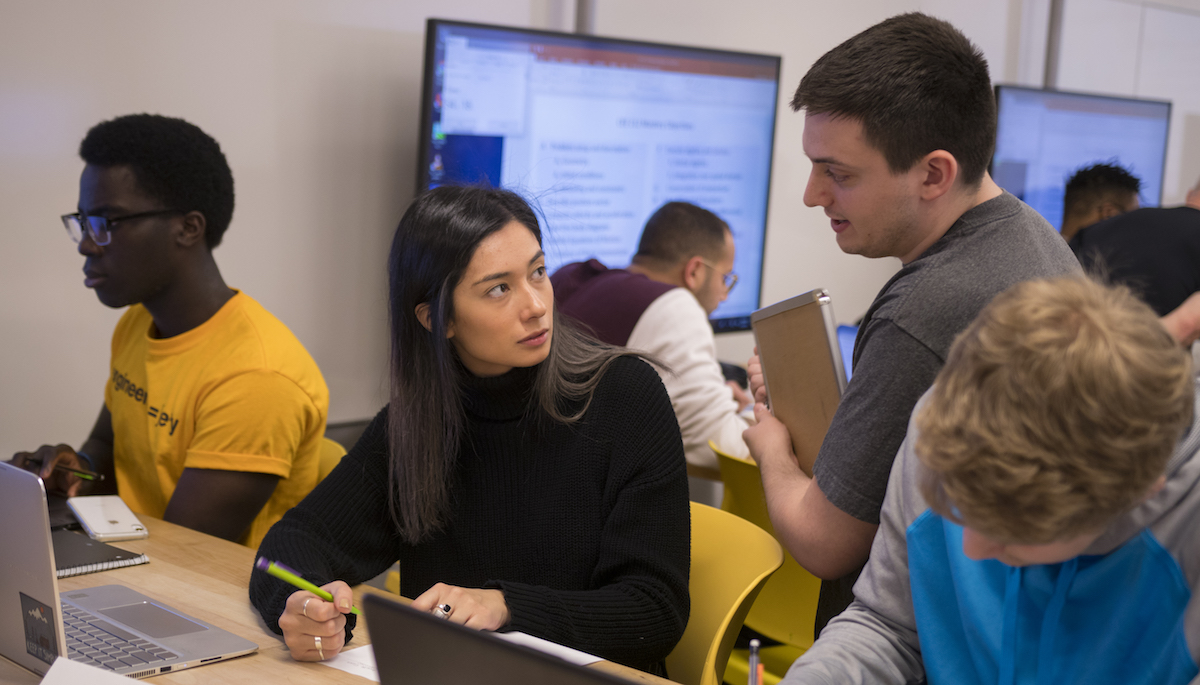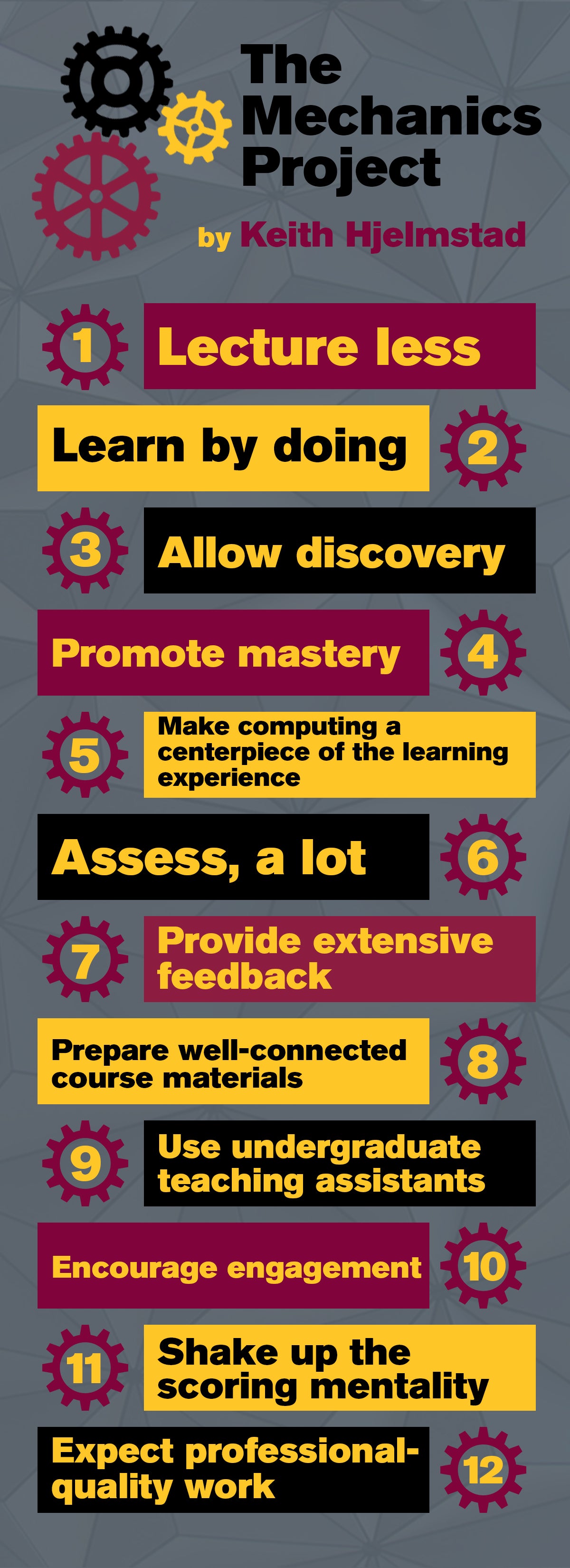Reimagining education leads to President’s Professor honor

Keith Hjelmstad (middle) was named an ASU President's Professor in recognition of his ability to engage, challenge and excite undergraduate students by creating an innovative, highly engaging learning environment. Photo by Marco-Alexis Chaira/ASU
When Keith Hjelmstad first arrived at Arizona State University in 2008, it was as university vice president and dean of the College of Technology and Innovation. In 2011, he joined the Ira A. Fulton Schools of Engineering as a structural engineering professor in the School of Sustainable Engineering and the Built Environment, one of the six Fulton Schools.
Hjelmstad was one of five ASU faculty members named President’s Professor in 2018. The honor recognizes faculty who have made substantial contributions to undergraduate education at ASU.
“I am truly humbled by the honor of being named a President’s Professor,” said Hjelmstad. “I am deeply appreciative that ASU places enough value on the teaching mission to have such a distinction.”
Upon his arrival, Hjelmstad’s colleagues asked him about teaching the foundational sophomore-level engineering mechanics courses. He agreed to teach the dynamics course, setting the roadmap for what would become "The Mechanics Project" — his effort to rethink how engineering mechanics is taught to undergraduates.
Hjelmstad’s inspiration to improve teaching for undergraduates is simple.
“We ask students to make a huge leap as they progress from high school to the profession of engineering,” he said. “They deserve the very best we can offer to put them in a position to succeed. These students are the future, and investing in the future seems like a good thing to do.”
Modernizing structural engineering education
Before arriving at ASU, Hjelmstad had been practicing and teaching computational mechanics at the graduate level his entire professional life. So when asked to take a look at the undergraduate courses, he wanted to give them a fresh view. Though he had not taught undergraduate mechanics before, having taught the courses downstream from it gave him insight into what might be most important for students to grasp.
He also realized the textbooks and approaches widely used to teach the subject had not changed much since he was a student taking mechanics courses 40 years earlier.
“The approach to learning the foundational ideas of mechanics were sort of stuck in time,” said Hjelmstad, “but the way engineers function and the tools they use have changed significantly.”
The work of structural engineering is evolving, so one of the biggest challenges to teaching it is imagining the role of engineers in the future and what they will really need to know.
“As it is with most things these days, it is innovate or die,” said Hjelmstad. “We need to find the ideas and approaches that take us to the future. Education can drive the evolution.”
Though as Hjelmstad knows firsthand, change can be difficult.
The “chalk and talk” approach to lecturing was Hjelmstad’s chosen teaching method for 30 years, but he has learned it is not the best learning environment for students. Research suggests active engagement helps students retain information far better than passive lecture.
Hjelmstad believes it is important to have a variety of methods for students to learn rather than relying solely on lectures and tests. Having options helps eliminate invisible barriers to success that may exist in the traditional classroom setting.
“Engineering education is not just about learning a set of recipes that you can cook with forever,” said Hjelmstad. “It is a mindset, a way of thinking. The earlier you can begin to form that mindset the more likely it is that students will benefit from it.”

Hjelmstad brings in undergraduate teaching assistants during recitations to foster an air of discovery, discussion and mutual learning for his students. Photo by Marco-Alexis Chaira/ASU
The Mechanics Project
Hjelmstad’s approach to classroom teaching didn’t change overnight. Over the years, he tried many times to make small incremental changes to his teaching, only to be lured back into his long-held habits of lecturing.
“There are some pretty deep ruts, and change always faces the headwinds of opposition,” said Hjelmstad. “What we have tried to do through The Mechanics Project is to show that change is possible.”
The Mechanics Project is the name Hjelmstad gave to a broad effort to reform sophomore-level courses in mechanics (Statics, Dynamics and Deformable Solids). These courses represent a bridge between the math and science of students’ freshman year and the upper-division engineering application courses of civil, mechanical and aerospace engineering curricula and others.
One key component to The Mechanics Project, and a new approach to teaching for Hjelmstad, is “recitation.” In recitation, the students work in groups on a problem of the day, while the instructional team — the instructor and group of undergraduate teaching assistants — provide guidance.
“The first time I walked into recitation I honestly did not know what to do,” explains Hjelmstad. “It was scary, but I kept my promise not to lecture. I quickly learned how to function in the recitation environment, and now it is my favorite part of teaching.”
In his courses, Hjelmstad has revised the class schedule so there is one lecture every two weeks, four recitation periods and one exam. One of the recitations is actually a rehearsal exam to help get ready for the module assessment.
“The first time I walked into recitation I honestly did not know what to do. It was scary, but I kept my promise not to lecture. I quickly learned how to function in the recitation environment and now it is my favorite part of teaching.”
— ASU President's Professor Keith Hjelmstad
Another important aspect of Hjelmstad’s teaching philosophy is to diagnose problems through understanding and execution. As a traditional lecturer Hjelmstad taught the mythical student — a composite of every student he has known that held common misconceptions about the subject matter. That changed with his new method.
“When I flipped my classroom, I saw where the students were actually struggling, and it was often not where I thought they would be struggling,” said Hjelmstad. “I think we spend too much time answering the wrong questions in the traditional learning environment. You also need to create an environment where students feel comfortable asking questions.”
Putting students’ needs first and employing an instructional team that includes undergraduate teaching assistants creates a student-centered learning environment that is highly personalized, adaptable and very responsive. Hjelmstad’s teaching model fosters a social learning infrastructure that allows for peer-to-peer learning that continues to operate beyond the classroom.
“These classes are challenging. The undergraduate teaching assistants don’t just help the students; they are proof that these difficult ideas can be learned. The entire instructional team participates on the motivation side of the ledger,” said Hjelmstad, who is a strong believer in peer-to-peer learning.
If you think of the course instructor as “the one who knows,” then you create a bottleneck for learning. The instructor is not always available and cannot always respond in a timely manner, so building a learning network is key.
“If you enhance the network then you solve part of that bandwidth problem,” said Hjelmstad. “Students do not automatically know how to participate productively in this networked environment. We take that on as part of the learning process.”
Keith Hjelmstad is the fourth Fulton Schools faculty member to be named a President’s Professor at ASU joining James Adams, Braden Allenby and Mark Henderson.
Improving teaching without altering content
Hjelmstad’s book, "A Walk in Euler’s Footsteps: Case Study in Teaching Engineering Dynamics through Pedagogies of Engagement," serves as a guide to others looking to transform engineering education based on The Mechanics Project.
In his book, Hjelmstad breaks down the methods that he has utilized to reform how courses in mechanics are taught at ASU. See the list below.
More Science and technology

Diagnosing data corruption
You are in your doctor’s office for your annual physical and you notice the change. This year, your doctor no longer has your…
Large-scale study reveals true impact of ASU VR lab on science education
Students at Arizona State University love the Dreamscape Learn virtual reality biology experiences, and the intense engagement it…

ASU-led space telescope is ready to fly
The Star Planet Activity Research CubeSat, or SPARCS, a small space telescope that will monitor the flares and sunspot activity…


